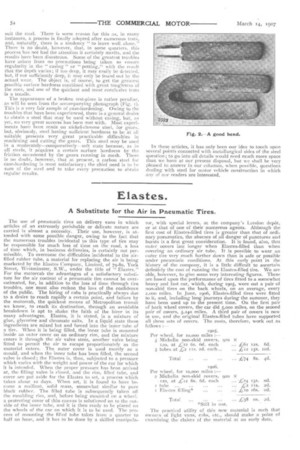Elastes.
Page 54

If you've noticed an error in this article please click here to report it so we can fix it.
A Substitute for the Air in Pneumatic Tires The use of pneumatic tires on delivery vans in which articles of an extremely perishable or delicate nature are carried is almost a necessity. Their use, however, is attended with some possible danger, owing to the fact that the numerous troubles incidental to this type of tire may be responsible for much loss of time on the road, a loss of time which, in business deliveries, is certainly not permissible. To overcome the difficulties incidental to the airfilled rubber tube, a material for replacing the air is being marketed by the Elastes Company, Limited, of 79-8o, York Street, Westminster, S.W., under the title of " Elastes," For the motorcab the advantages of a satisfactory substitute for the air content of a pneumatic tire cannot be overestimated, for, in addition to the loss of time through tire troubles, one must also reckon the loss of the confidence of the public. The hiring of cabs is practically always due to a desire to reach rapidly a certain point, and failure by the motorcab, the quickest means of Metropolitan transit we know, to reach its destination, through an avoidable breakdown is apt to shake the faith of the hirer in its many advantages. Elastes, it is stated, is a mixture of glue, glycerine and chromate salts. In a liquid state these ingredients are mixed hot and forced into the inner tube of a tire. When it is being filled, the inner tube is mounted inside an outer cover on an ordinary rim, and the mixture enters it through the air valve stem, another valve being fitted to permit the air to escape proportionately as the material enters. The outer cover is used merely as a mould, and when the inner tube has been filled, the second valve is closed ; the Elastes is, then, subjected to a pressure which varies with the weight and power of the car for which it is intended. When the proper pressure has been arrived at, the filling valve is closed, and the rim, filled tube, and cover are put aside for the Elastes to set, a process which takes about in days. When set, it is found to have become a resilient, solid mass, somewhat similar to pure black rubber. The filled tube is subsequently taken off the moulding rim, and, before being mounted on a wheel, a protecting cover of thin canvas is solutioned on to the outside of the inner tube, and it is then ready to be placed on the wheels of the car on which it is to be used. The process of mounting the filled tube takes from a quarter to half an hour, and it has to be done by a skilled manipula tor, with special levers, at the company's London depOt, or at that of one of their numerous agents. Although the first cost of Elastes-filled tires is greater than that of ordinary pneumatics, the absence of all danger of punctures and bursts is a first great consideration. It is found, also, that outer covers last longer when Elastes-filled than when covering an ordinary air tube. It is possible to wear an outer tire very much further down than is safe or possible under pneumatic conditions. At this early point in the history of the company, it is a little difficult to ascertain definitely the cost of running the Elastes-filled tire. We are able, however, to give some very interesting figures. These are based upon the performance of tires fitted to a somewhat heavy and fast car, which, during 1905, wore out a pair of non-skid tires on the back wheels, on an average, every 2,000 miles. In June, 1906, Elastes-filled tires were fitted to it, and, including long journeys during the summer, they have been used up to the present time. On the first pair of back wheel covers, the car did 5,000 miles, on the second pair of covers, 5,240 Trifles. A third pair of covers is now in use, and the original Elastes-filled tubes have supported all three sets of covers. The costs, therefore, work out as follows :—
1905.
Per wheel, for mo,000 miles :— 5 Michelin non-skid covers, 920 x
120, at L12 bs. 6d. each £6' 125. 6d.
s tubes at 4T2 ITS. 2d. each... .4'12 15S. mod.
Total ... ••• £74 8s.
1906.
Per wheel, for mo,000 miles :— 2 Michelin non-skid covers, 920 x
120, at :4'12 6s. bd. each L-24 155. od. tube ... £2 115. 2d.
T Flastes m6s. • od.
Total ... £38 os. 2d.
in use, The practical utility of this new material is such that owners of light vans, cabs, etc., should make a point of examining the claims of the material at an early date.
































































